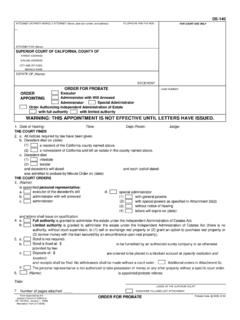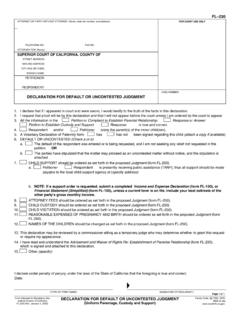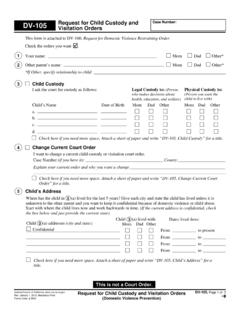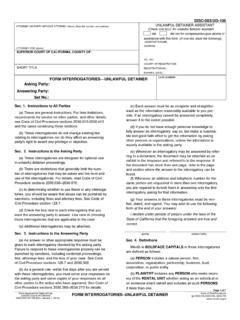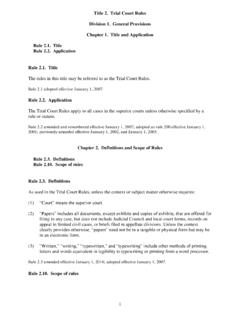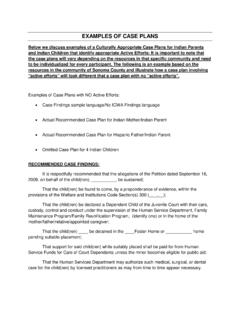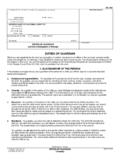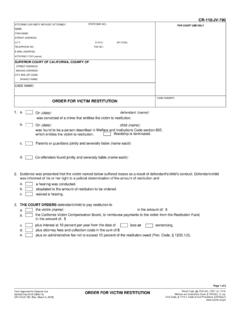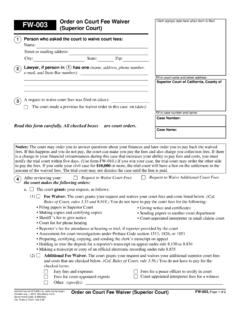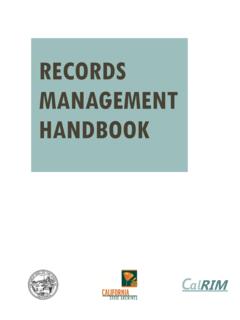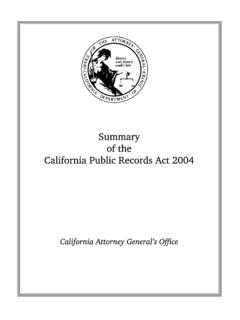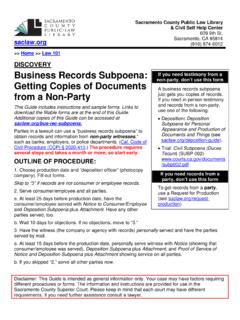Transcription of Trial Court Records Manual - California
1 Trial Court Records Manual REVISED JANUARY 1, 2019 Trial Court Records Manual Revised January 1, 2019 i CONTENTS 1. Introduction ..1 Background .. 2 Purpose of Records Management .. 3 Purpose of the Manual .. 5 Life Cycle of a record .. 5 Key Definitions .. 7 2. Statutes and Rules of Court Governing Trial Court Records Management ..8 California Government Code .. 8 Signatures on Electronically Created Court Documents .. 8 California Rules of Court .. 8 3. Records Management 10 Application of Standards .. 10 Responsibility for Effective Records Management.
2 10 Duties and Responsibilities of Records Managers .. 10 Records Management Training .. 11 4. Creation, Filing, and Retrieval of Court Records .. 12 Court record Creation Process .. 12 Filing Papers in Court : Methods of Filing .. 12 Filing Papers in Court : Form and Format Requirements .. 19 Filing Papers in Court : Role of Civil Fees and Fee Waivers .. 20 Numbering Schematic for Court Records .. 22 Filing Systems for Court Records Maintained in Paper Format .. 22 Numerical Filing Systems by Case Numbers .. 23 Alphanumeric Filing Systems by Case Numbers .. 23 Terminal Digit Filing Systems by Case Numbers.
3 24 Electronic Format Filing Protocols .. 25 E-Filing Overview .. 25 Court record Location Tracking .. 26 Paper record Tracking .. 26 Electronic File Tracking and Security .. 27 5. record Classification .. 29 Standard record Classifications .. 29 Case record Classification .. 29 Prefiled 31 ii Lodged Records .. 31 Exhibits .. 31 Juror Records .. 31 Confidential and Sealed Records .. 32 Subpoenaed Records and Documents .. 32 6. Storage, Maintenance, and Electronic Signing of Records .. 33 Industry Standards for Storage of Paper and Electronic Records .
4 33 Recommended Standards for Paper Records Storage Facilities .. 33 Recommended Standards for Managing Microfilm .. 34 Electronic Records .. 35 Process Review .. 36 File Format Best Practices .. 36 Color Palettes .. 39 Digital Imaging and Scanning Best Practices .. 41 Technology Refresh .. 44 Data Backup and Storage .. 46 Retention and Destruction .. 48 References .. 48 Electronic Signatures: Standards and Guidelines .. 49 Electronic Signatures on Court -Created Records .. 49 Electronic Signatures on Documents Submitted to the Courts .. 54 Signatures on Scanned Documents.
5 60 7. Exhibits Management .. 61 Receiving, Handling, and Transfer of Exhibits in Criminal Cases .. 61 Receiving, Handling, and Transfer of Exhibits in Civil ..61 Protocols for Dangerous and Biohazard Exhibits .. 62 Exhibits That Pose a Security, Storage, or Safety Problem .. 62 Exhibits That Are Toxic .. 62 Dangerous or Deadly Weapons, Poisonous Drugs, Explosives, or Any Property Prohibited by Law and Biological Material for DNA Testing .. 63 Protocols for Cash Value, Historical Value, Narcotics, Sensitive Photographs, Private Property .. 63 Exhibits Composed of Money or Currency of Unknown Ownership.
6 63 Exhibits Composed of Stolen or Embezzled Money or Currency .. 64 Exhibits Composed of Property Other Than Money or Currency That Is Unclaimed .. 64 Exhibits Composed of Property Value That Is Unclaimed .. 64 Exhibits Composed of Photographs of Minors Deemed Harmful .. 64 Death Penalty Exhibits .. 65 iii 8. Public Calendars, Indexes, and Registers of Action Minimum Standards .. 66 Minimum Content for Court Calendars, Indexes, and Registers of Action .. 66 Historical Data Fields Restrictions .. 67 9. Disaster Recovery Planning and Procedures .. 68 Planning for a Disaster.
7 68 Response to Disasters .. 68 Disaster Recovery .. 68 10. Public Access to Court Records .. 70 Public Access to Trial Court Records .. 70 Paper Court Records .. 70 Electronic Court Records .. 70 Remote Electronic Access Allowed in High-Profile Criminal Cases .. 71 Confidential and Sealed Records .. 72 Confidential Records .. 72 Sealed 82 Fees and Fee Waiver Guidelines for Requested Records .. 83 Judicial Administrative Records .. 83 11. Retention, Preservation, and Destruction of Court Records .. 84 Retention, Preservation, and Destruction Practices .. 84 Court Records Sampling Program.
8 85 Inactive Records Storage .. 87 Noncapital Cases in Which the California Supreme Court Issues a Written Opinion .. 87 Schedule of Records Retention and Destruction and Special Case Type Characteristics .. 88 Records Retention and Destruction Schedule under Government Code sections 68152 and 68153 .. 88 Records Retention and Destruction Schedule for Other Case Types .. 105 Records Retention and Destruction Schedule for Prefiled and Juror Records .. 106 Appendixes .. 107 Appendix 1 Court Records Designated Confidential by Statute or Rule .. 108 Appendix 2 Rotational Assignment for Longitudinal Sample.
9 123 Index .. 127 1 1. Introduction This Trial Court Records Manual (TCRM) has been developed by Court administrators for Court administrators and is published under the direction of the Judicial Council of California . The vision of the Court administrators and Judicial Council staff who drafted the TCRM is to encourage and embrace input and participation from Trial Court leaders and subject matter experts in every Court so that the TCRM is not only a reference Manual of laws and rules governing Court Records management but also a repository for our best ideas and programs. This Manual is not considered final or complete; additional content will be drafted for subsequent versions and distributed to Trial Court leaders for comment as those versions become available.
10 As the Judicial Council adopts, and the Trial courts begin to implement, new policies for the creation, maintenance, retention, and destruction of electronic Records , the TCRM seeks to address the issues and challenges that Trial courts will encounter with archival and current paper Records , as well as to describe the new policies, business practices, and technology considerations that will lay a solid foundation for managing electronic Records in the future. As the Trial courts business model changes with the advent of new technologies, courts are encouraged to develop strategic solutions that will position them to adapt to emerging trends in paperless Records management.
